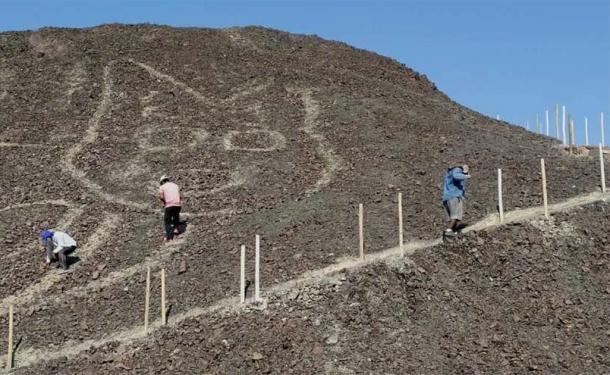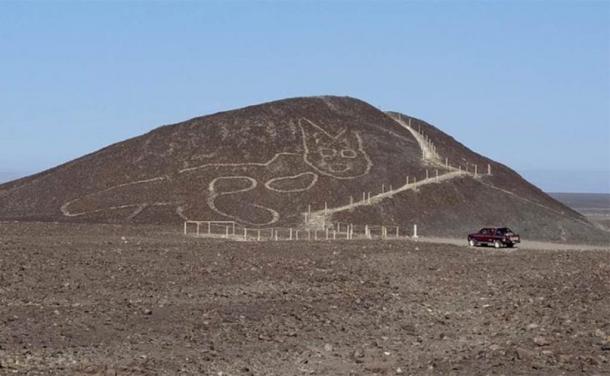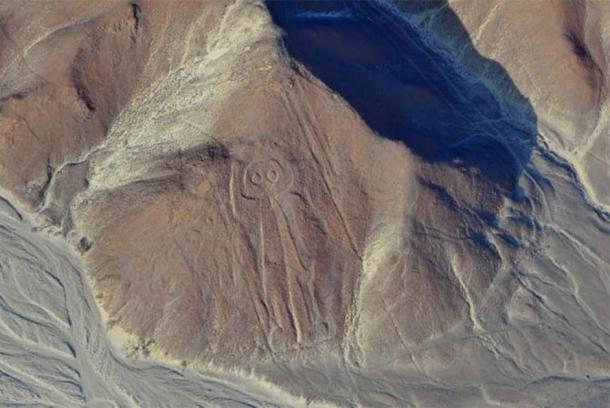Experts have found a giant new cat geoglyph in Peru near the world-famous Nazca Lines. They identified the huge figure of the feline on a hill that overlooks the pre-Hispanic designs and features. The find can help experts to better understand the most famous geoglyphs in Latin America, if not the world.
A conservation management team discovered the cat geoglyph on a well-known hill in the coastal desert in southern Peru. It was found in the Nazca-Palpa Archaeological Park, some 200 miles (321.87 km) south of Lima. Jhonny Isla, leader of the conservation management system at the park, stated that the image was found during work to improve access to a visitor look-out point, enabling people to view the giant figures that make up the famous and mysterious Nazca Lines. These geoglyphs were made by people of the Palpa and Nazca cultures between 500 BC and 500 AD.

The cat geoglyph was found during work to improve access to a visitor look-out point. ( Peruvian Ministry of Culture )
Unearthing the Giant Cat Geoglyph
During the conservation project, workers found lines that were “definitely not natural,” according to Mr. Isla. Sky News reports that the archaeologists found the huge design of a cat, ‘with the head drawn high up on the hill and looking straight ahead, the body and tail extended further down.’ The cat geoglyph is impressive, it measures 37 meters (121 ft), and the lines of the design are about 10 inches (25.4 cm) wide.
Peru’s Ministry of Culture states that “The design was hardly visible when it was first identified and was on the verge of disappearing because it was on a hill with a steep slope and was subject to the effects of natural erosion.” The management team cleaned away stones and debris to disclose the lines. In just over a week they were able to reveal the feline image for the first time in possibly centuries.
Art by a Mysterious Culture
Based on the design of the cat geoglyph, experts believe that that it dates to 200-300 BC. This was the period when the mysterious Palpa or Paracas culture began to create the designs in the desert. This society probably began the tradition of making the images and lines.

Based on the design of the cat geoglyph, experts believe that that it was made by the Palpa culture. (Prensa Libre )
The Nazca emerged from this culture and continued the tradition of making geoglyphs. The Peruvian Ministry of Culture website states that “Representations of felines of this type are common in the iconography of ceramics and textiles of the Palpa society.” The discovery of the giant cat geoglyph can help experts to better understand the earlier culture’s contribution to the Nazca Lines, which were only rediscovered in the early 20th century.
The mysterious Peruvian geoglyphs cover an area of 75,358.47 hectares and there are thousands of lines and images cut into the dry and sandy soil. They include depictions of animals, weird creatures , and human-like figures. There are also many geometric designs.

Earlier found geoglyphs including another cat. (National Geographic )
According to Andina, the glyphs have turned ‘the vast land into a highly symbolic, ritual and social-cultural landscape that remains until today.’ They are probably the most diverse and numerous glyphs to be found anywhere in the world and for this reason the area was awarded the status of a UNESCO World Heritage site in 1994.
Religious Purpose of the Nazca Lines
For centuries people of both the Nazca and Palpa culture made the glyphs for religious and ritual purposes . ‘They represent a remarkable manifestation of a common religion and social homogeneity that lasted a considerable period of time,’ reports Andina.
On the other hand, some have speculated that the Nazca Lines were made as part of irrigation schemes . In the past, some argued that because the glyphs can only be seen from the air , they are the work of aliens, but this had been discredited by experts.
Jhonny Islas stated that “it is likely there are even more designs out there waiting to be discovered.” A large number of geoglyphs have been found in recent years , including hundreds that have been identified by a team from Japan’s Yamagata University. New technologies and drones allow the vast and desolate desert to be surveyed and this means that more designs are coming to light.

Aerial view of the Nazca Lines Owlman (astronaut), Peru. ( Cezary Wojtkowski /Adobe Stock)
The latest find could lead to an increase in tourists to the Nazca-Palpa Archaeological Park. However, many are increasingly anxious about the impact of erosion and pollution created by increased visitors to the Nazca Lines.
Top image: The cat geoglyph found near the world famous Nazca Lines. Source: Peruvian Ministry of Culture
By Ed Whelan
 RSS Feed
RSS Feed















 October 18th, 2020
October 18th, 2020  Awake Goy
Awake Goy  Posted in
Posted in  Tags:
Tags: 













